Do Acrylic Paints Go On Porcelin?
Ceramics is a centuries-old business organization that predates history itself. The earliest known ceramic sculpture is the Venus of Dolni Vestonice, a footling feminine figure discovered in a tiny ancient hamlet in the Czechia that traces its origins to 28,000 BCE. Ceramics is now not just a successful enterprise, merely also a pop pastime. In this essay, we volition look at ceramics, talk about painting ceramics with acrylic pigment, and clarify the ideal sort of pottery to pigment.
Tabular array of Contents
- 1 What Is the Best Sort of Pottery to Paint?
- 2 The Platonic Paint for Pottery Projects
- ii.1 Curing Time
- two.ii Color
- two.3 Lightfastness
- 2.four Dishwasher Friendliness
- 2.five Our Acrylic Paint Recommendation: CRAFTS 4 ALL Acrylic Paint Set
- three A Guide to Painting Ceramics
- 3.1 Preparing Your Ceramics for Painting
- 3.2 Painting Ceramics with Acrylic Paint
- 4 Often Asked Questions
- 4.1 What Is the Platonic Ceramic to Apply Paint to?
- iv.2 What Is the Ideal Paint for Coloring Pottery?
- iv.iii Is There a Difference Between Ceramics and Pottery?
What Is the Best Sort of Pottery to Paint?
The term ceramic has evolved to refer to any type of pottery, whether coated or unglazed, painted or unpainted ceramics. We volition examine three different types of ceramics earlier deciding which one is platonic for painting. Greenware refers to pottery in its purest form. This refers to dirt that has been air-stale simply not burned in a furnace. Greenware is exceedingly delicate and has a limited lifetime, making information technology unsuitable for coloring or art. Additionally, decorating pottery that'south not been kiln-fired would exist problematic since paints for pottery, even if available, would not stick to the exterior of the clay.
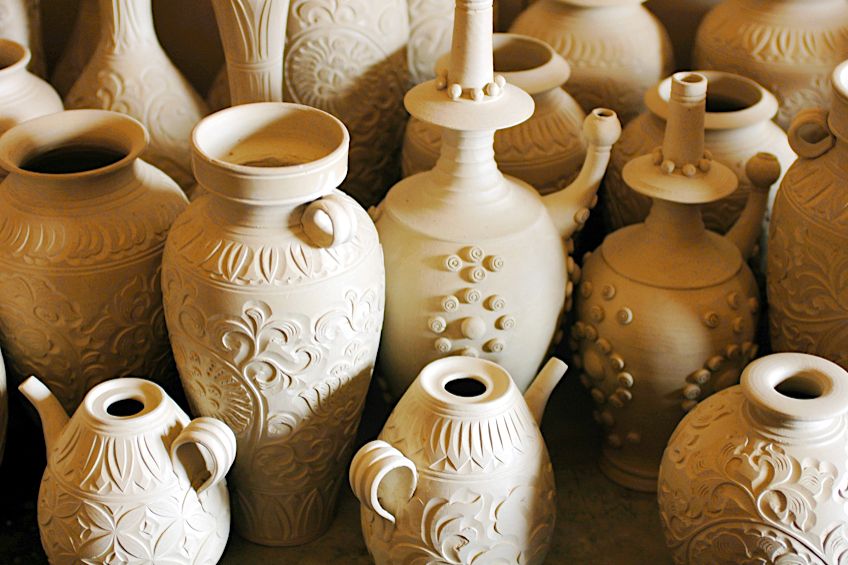
Glazed pottery is another form of ceramic that has been air-dried, fired once in a furnace, and and then has ceramic glazes added to it. Subsequently the glaze has been added, the ceramic object is re-fired at a greater temperature in the furnace. Although this sort of ceramic is watertight and dishwasher-friendly, it cannot be painted since the paint does non adhere to the glazing. Bisque is the greatest type of pottery to pigment on.
It is unglazed greenware that has become air-dried and then broiled in a prepared heat furnace. Bisque ceramics are firm and sturdy after being kiln-fired, and since they are permeable, they are suitable for acrylic paint.
Because paint absorbs into the clay, you may need to utilize more coats to reach the desired hue, but once dry, the paint will not peel, chip, or break. Bisque pottery is classified into 3 types: pure white porcelain bisque, terracotta-colored earthenware, and gray-colored stoneware, and. Acrylics may be used to paint all three types of bisque.
The Ideal Paint for Pottery Projects
Acrylic paints are the best paints to employ for painting pottery. Because the pigment is oil-based, information technology is incredibly flexible and may be utilized to paint nigh whatever you can think of. Many dry to a matte cease, while others dry to a sleeky sheen or a satin finish. They are highly tough and will not crack, bit, or fade. Bated from these platonic features, in that location are a few more than to be aware of.
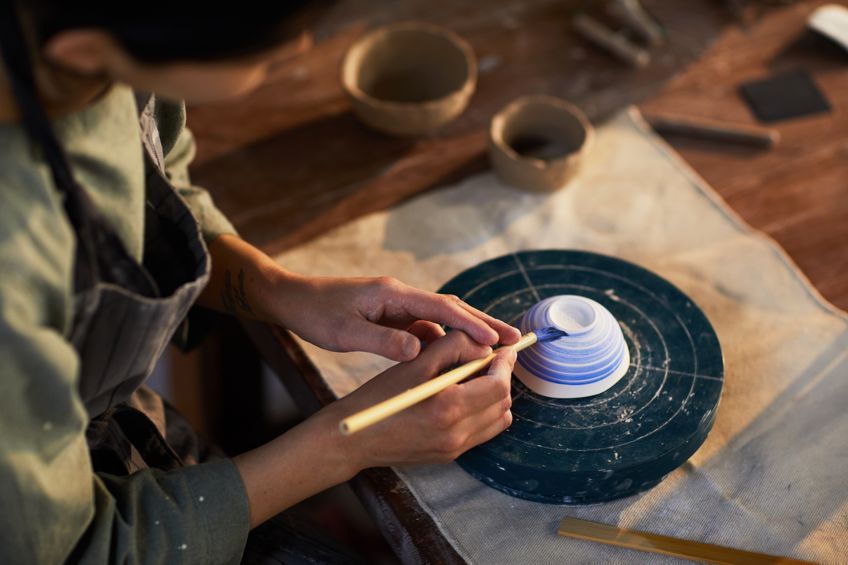
Curing Time
Drying time or curing is critical. Acrylic paint on ceramics must be allowed to cure for a flow of fourth dimension, ideally no more than 48 hours. Ideally, search for paint that can be dried in an oven equally a substitute.
Paint that takes more than 48 hours to cure is not desirable, particularly if you program on painting numerous layers onto your ceramic work.
Color
When painting ceramics using acrylic paint, seek paint that comes in a diverseness of hues. You may use any color direct from the canteen, or one tin mix hues to make new ones. When it relates to specialized paint for pottery, yous could find a hue that is distinctive to you and develops your own unique "signature" shade.
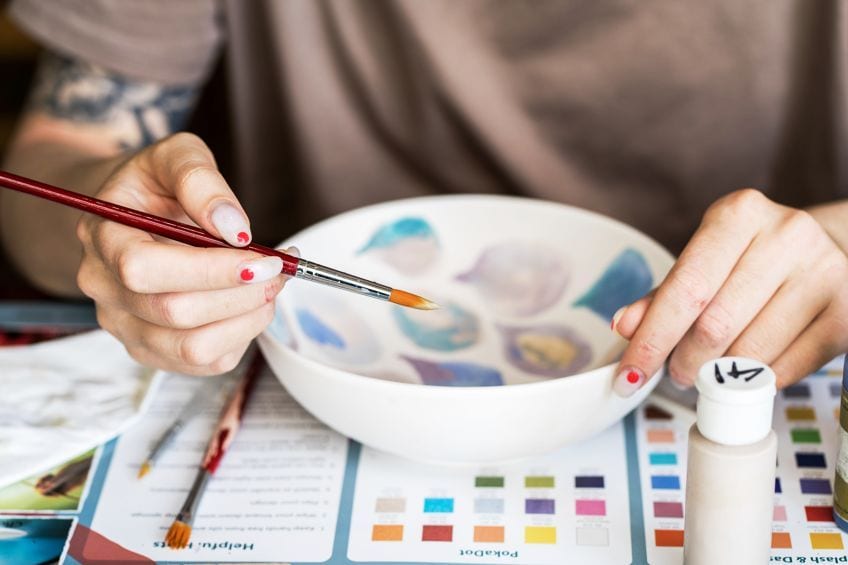
Lightfastness
A lightfast paint will not dethrone, turn yellowish with fourth dimension, or grow transparent over time. This is the sort of paint y'all crave for your ceramics since you don't want to have to refinish or make clean up the paint job on them all the time.
This is an essential event since you lot desire to be able to appreciate the splendor of your ceramics objects for a long time.
Dishwasher Friendliness
If you want to utilize your ceramics for drinking and eating, make sure the pigment you use is dishwashing suitable in one case it has been dried. Check that the pigment is likewise food appropriate; else, your nicely painted pottery would be useless.

Our Acrylic Pigment Recommendation: CRAFTS four ALL Acrylic Paint Set
Crafts iv All have been in the industry for a long time, and their acrylic pigment for ceramics is among the successful items in the industry. The kit includes 24 brilliant colors and 3 paintbrushes that take been created for optimum colour definition and intensity. This acrylic paint is perfect for ceramics, every bit well as various textures and forms.

- Uniquely crafted acrylic paints deliver colour clarity and brilliance
- Suitable for well-nigh mediums, including ceramic, wood, and glass
- Not-toxic composition makes the paints suitable for children
View on Amazon
The paints are fully non-toxic, making them suitable for both children and adults. When using this acrylic paint on ceramic, users will exist fix to simply combine various colors and paint layers atop each other to produce intriguing patterns and optical furnishings on your pottery. Within 48 hours, the paints dry to a cute opaque and satin sheen.
PROS
- The pigments were created specifically for painting pottery
- They are non-toxic, making them food safe and excellent for usage by both children and adults
- They dry rapidly
- There are 24 different colors to option from
- Layering and mixing are possible considering of the thick consistency
CONS
- Colors aren't every bit vibrant every bit they wait in the tube
- The containers just agree 0.four fluid ounces of production
- and the brushes included are crudely constructed and lose beard
A Guide to Painting Ceramics
Afterwards your unpainted ceramics have been burned in the oven and thoroughly cooled, there are a couple of other steps you lot demand to practise before you begin painting them. These are short and unproblematic tasks that will save y'all loads of time and brand your process much simpler.
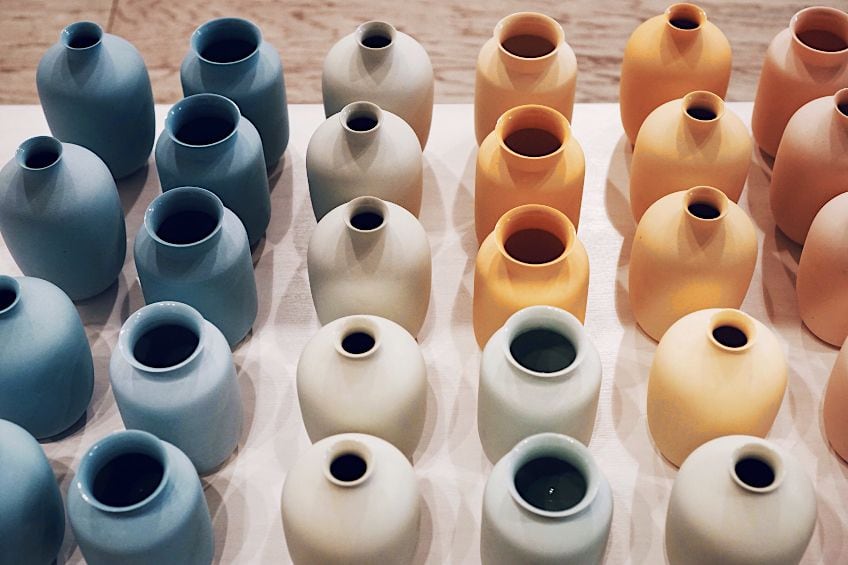
Preparing Your Ceramics for Painting
Earlier you start putting acrylic paint on ceramic objects, there are a few things you should exist informed of and prepared for. Here'due south a quick rundown of some of the nearly crucial items to call up about before y'all outset painting pottery.
Unpainted ceramics, every bit previously said, are incredibly permeable and nearly pull in the pigment as you paint information technology. This is good if you don't mind using a lot of paint to larn the colour and cease you desire, merely nosotros advise that you prime number the surfaces of the ceramics with spray acrylic.
Acrylic paint on ceramic works the best if the object has been primed start because, while the substrate remains absorptive to some extent, the acrylic paint will attach to the fabric without being totally captivated. When you're ready to brainstorm painting, don't put also much paint and water on your paintbrush at in one case. To brainstorm, tap your paintbrush over your water pitcher or a piece of tissue towel to remove any extra moisture, and and then immerse it into the acrylic paint when no more liquid is visible. If you practice not execute this procedure, the pottery will soak the water, leaving the pigment blotchy and leaking.
The procedure of painting pottery with acrylic paint is like working on canvases or any other media. Acrylic paint dries fast, generally within 5 to ten minutes of existence applied, presuming yous have non layered the paint too thickly. You may apply as many coats of paint as yous like, as long equally you lot let each layer cure between coats.
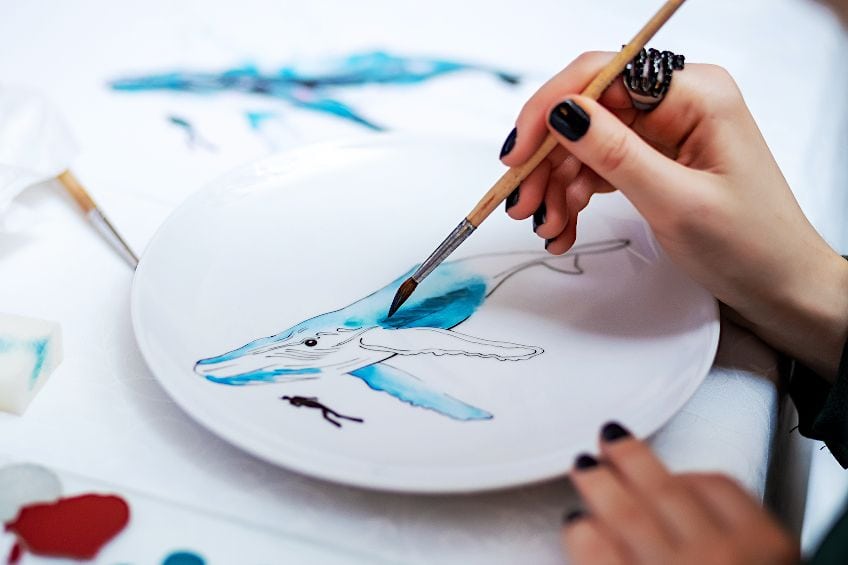
A handful of potters enjoy painting images of people on their ceramics. The challenge is to larn how to accurately reproduce human complexion – unless your figurines are going to be painted in a uniform, single hue. The benefit of acrylics is that yous can combine them to brand different colors, and then creating skin tones should be very straightforward. For comparison, use images from periodicals and tabloids. The meliorate you go at blending colors, the more attractive your completed ceramic sculpture will be.
Painting Ceramics with Acrylic Paint
Subsequently y'all've prepped your unpainted ceramics, you'll be prepared to outset calculation pigment to the pieces. It is a proficient idea to have your colors, paintbrush, and water ready before you begin painting, equally this volition assist the painting process get more than easily. Note that acrylic paint dries rapidly, so y'all'll need to work rapidly.
You don't want to lose fourth dimension hunting for the proper color pigment or hunting for the h2o cup betwixt coats!
Step one: Cleaning Your Ceramic Slice
Before painting your pottery, ensure it is spotless and dust-free. Wipe it down get-go with a moist cloth to remove any dust or pocket-size pieces of pottery or other clay. Y'all don't want it to become tangled upward in your paintbrush since it volition ruin the appearance when y'all commence painting.

Step ii: Choosing Your Colors
Choose the colors you lot want to apply ahead of time, and so utilize every bit much as you require onto your color palette or even a porcelain plate. Information technology is not a great idea to pour pigment straight from the canteen onto your paintbrush since you will most probable pump out more than than you crave.
Additionally, the tubing should remain closed and so that oxygen does non enter and brainstorm drying off the pigment.
Step three: Choosing Your Painting Tools
To impart texture to your artwork, you can utilize sponges in add-on to your paintbrush. Furthermore, y'all do non have to utilise only one paintbrush; yous may use finer or wider ones depending on the subject you are creating and the effect you lot want to create. Thicker brushes are ideal for spreading a lot of paint, while finer brushes are ideal for precise touching upwards.
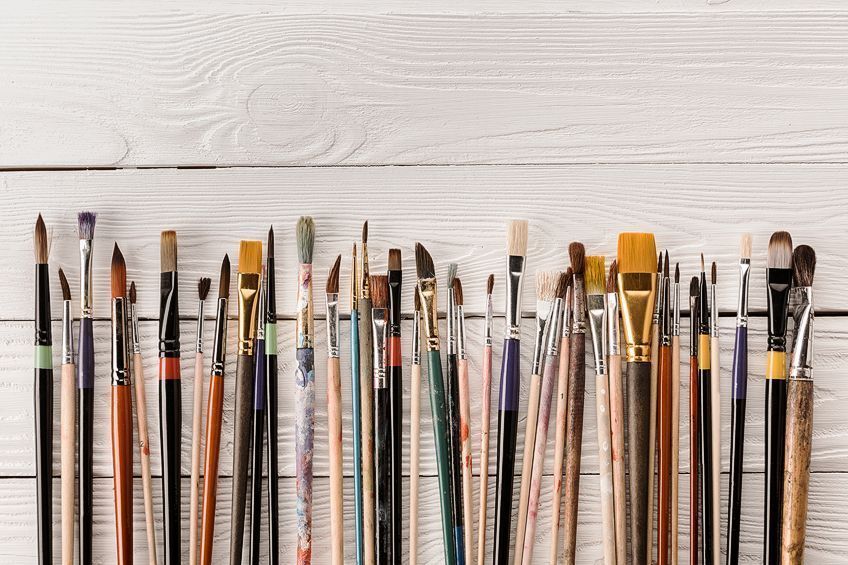
Step 4: Painting Your Ceramic Piece
If you intend to apply your ceramic item in the dining area or kitchen, that is, if yous intend to drink or eat from it, put a gap of approximately an inch from the rim free of pigment.
If the object is only for decoration, you can color it all the manner to the tip.
Step 5: Sealing Your Ceramic Artwork
After you've completed painting ceramics, use a spray acrylic sealer to seal the paint. This is likewise a great selection if you lot like a sparkly rather than a matte appearance. Because acrylic paint cannot suffer the heat of a firing, the only method to go that gleaming surface is to use a sealer.

Nosotros hope we've piqued your involvement in painting ceramics with acrylic pigment, and that you've already selected that unique unpainted ceramic object. Painting pottery is enjoyable and gratifying, and if you employ non-toxic paints like Craft 4 All, why not engage the kids as well?
Ofttimes Asked Questions
What Is the Platonic Ceramic to Apply Pigment to?
"Bisque" ceramic is the ideal type of ceramic to pigment on. This blazon of pottery refers to clay that has been air-dried before being burnt in a kiln. As a issue, every bit opposed to being a decorative item, bisque ceramics are incredibly robust and will retain their integrity even if the object is used regularly.
What Is the Platonic Paint for Coloring Pottery?
Acrylic paint is the simply pigment that may be used on ceramics. Acrylic is a very flexible media that may be used on practically any object you can excogitate of. It's ideal for pottery since information technology sticks and then well to the clay, however, it's all-time to coat the clay beforehand with clear acrylic spray paint. When painting acrylic paint on ceramic, you may apply thick layers to give visual appeal and depth to the work, similar to how you would with oil paint.
Is There a Difference Betwixt Ceramics and Pottery?
Ceramics are products created from dirt that undergo a transformation when warmed or fired, in an oven. Pottery is simply another name for ceramics, but information technology especially refers to receptacles used in the dining area or kitchen such as cups, bowls, and dishes.
Source: https://artincontext.org/painting-ceramics-with-acrylic-paint/
Posted by: barnettankining.blogspot.com

0 Response to "Do Acrylic Paints Go On Porcelin?"
Post a Comment